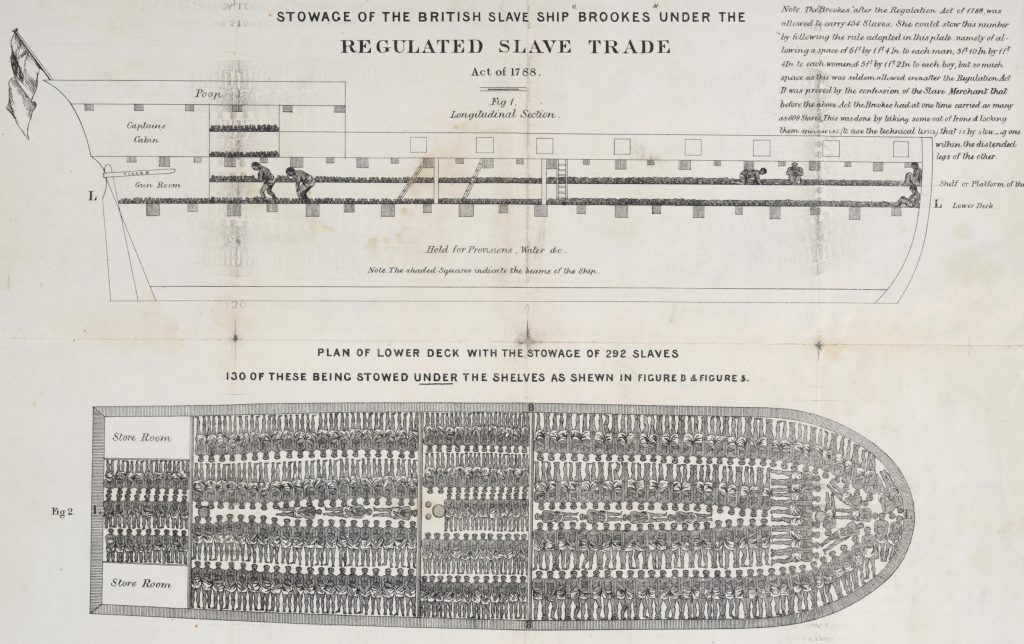Slavery: Then & Now

The year was 1789. Around the dining room were women and men of status and influence. Donned in elaborate gowns of brightly colored silk, layered with ruffles and lace, the women discussed the latest in London high society while the men, in their waistcoats and long overcoats, discussed business and politics. They were in between courses when one woman turned to the man next to her. She took out from between the folds of her dress a piece of paper and purposefully asked him if he had ever seen the inside of a slave ship. “No,” he replied, shocked that she would so pointedly ask him such a question at the dinner table.
The image depicted the ‘Brookes’ slave ship loaded to full capacity, with 454 slaves each crammed into a space so small that they couldn’t even lay their hands at their sides. And this ship often carried more than 600 slaves.
This woman was Hannah More, a close friend of William Wilberforce and a committed abolitionist. She used her writing to give voice to the anti-slavery movement. Karen Swallsow Prior, who wrote a biography of More, writes, “As a woman who could not vote or join abolitionist societies of the day, More was destined for obscurity. Yet historians agree she was the single most influential woman in the British abolitionist movement.”
She is largely unknown today, but the joint efforts of Wilberforce, More, and many others led to the Abolition of Slavery bill, passed in the House of Commons on July 26, 1833.
—-
A few weeks ago, a mainstream Cambodian newspaper published an article about young women who had been trafficked overseas. The mental damage, not fully understood by their families and communities, resulted in destructive and erratic behaviour, often leaving them in the margins upon their return home. While we typically envision victims of slavery chained in their abuse, these young women were chained within their homes by their families in desperate attempts to protect them. The trauma these young women endured had left them mentally unstable, and their families, in their lack of understanding, felt like they had no other choice.
Slavery continues to be a reality we must face. The UN estimates that there are 27-30 million people living as slaves, trapped in different forms of slavery and generating $150 billion each year in illicit profits.
The picture of slavery is different today, and it’s constantly changing. In Cambodia, sexual violence and domestic abuse are a societal norm. Children and young women from impoverished families in rural villages are trafficked to urban centres both inside and outside the country. Many are subjected to sexual exploitation in brothels, beer gardens, massage parlors, salons, karaoke bars and non-commercial sites. Often lacking education and job skills, these young women feel trapped in sexual exploitation with no alternative for income to support their families. Trafficking overseas for forced marriage is a growing issue, largely due to the staggering number of bachelor men in China who have no prospects of marriage. And just yesterday, Nestle admitted to slavery in its seafood supply chains, with Cambodians among the many migrant workers trapped working on fishing vessels and at ports, mills and seafood farms in Thailand.
So how do we respond? We join hands and speak out. Just as William Wilberforce and Hannah More refused to accept the injustices of their time, we must also take a stand and courageously work together to abolish modern day slavery. Whether it’s through prayer, support, raising awareness or being informed, we can all make a difference!
Was it decreed, fair Freedom! at thy birth,
That thou shou’d’st ne’er irradiate all the earth?
While Britain basks in thy full blaze of light,
Why lies sad Afric quench’d in total night?
–An extract from Hannah More: ‘Slavery, a poem’
Notes
Prior, Karen Swallow (2015, March 4). Hannah More: Powerhouse in a Petticoat. Christianity Today. Retrieved from http://www.christianitytoday.com/ct/2015/march/hannah-more-powerhouse-in-petticoat.html
Mendoza, Martha (2015, November 23). Nestlé admits slavery and coercion used in catching its seafood. CBC News. Retrieved from http://www.cbc.ca/news/business/nestle-seafood-thailand-1.3331127
Titthara, May and Alice Cuddy (2015, September 26). The Shackles of Abuse. Phnom Penh Post. Retrieved from http://www.phnompenhpost.com/post-weekend/shackles-abuse
